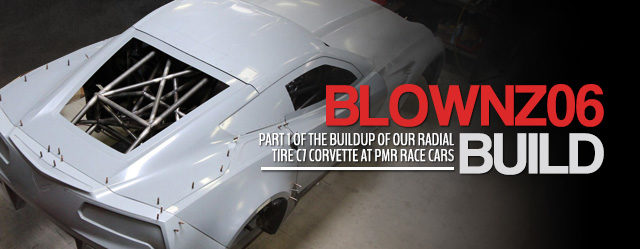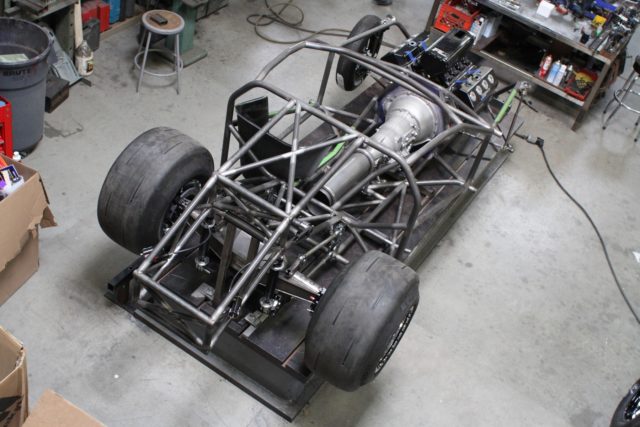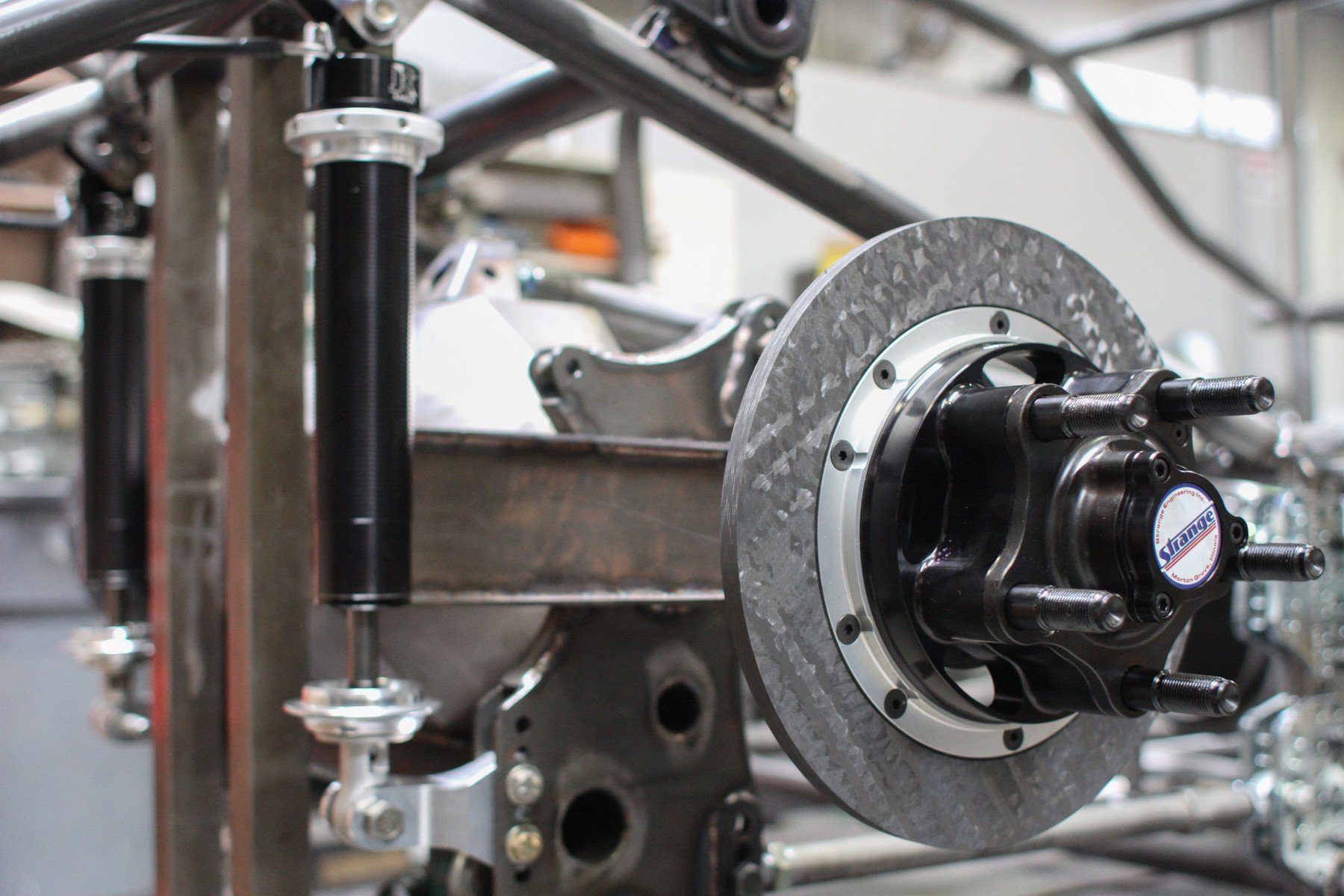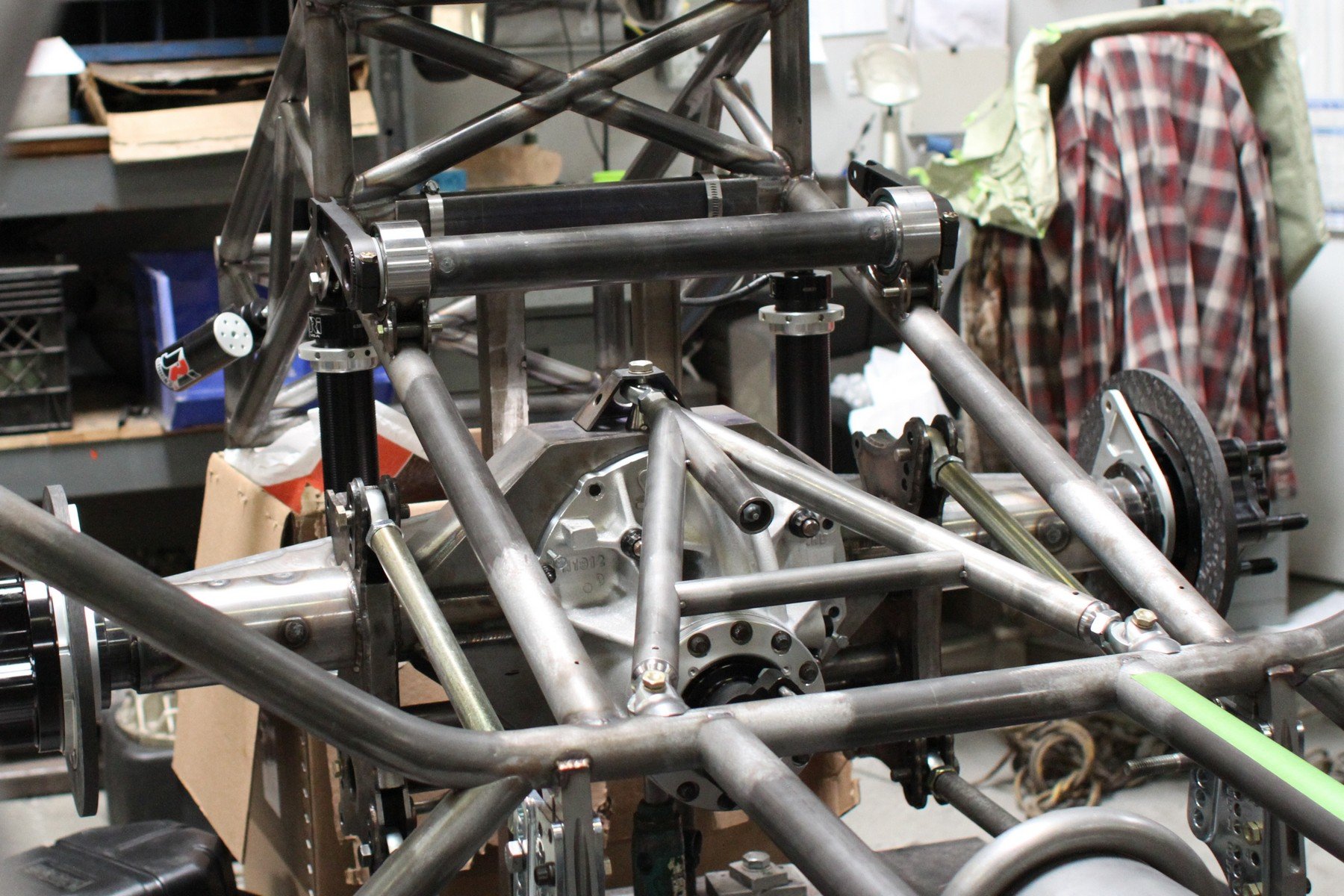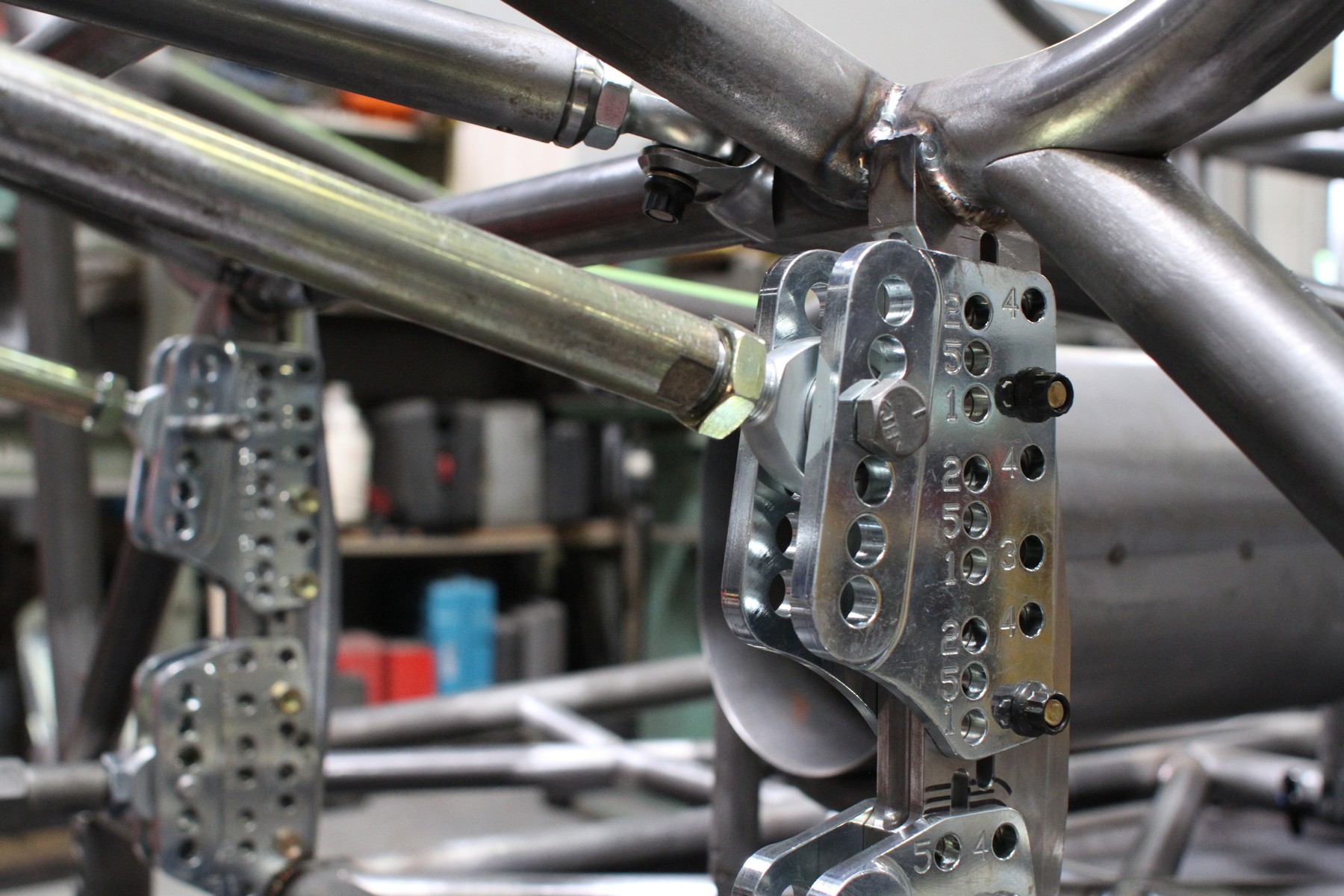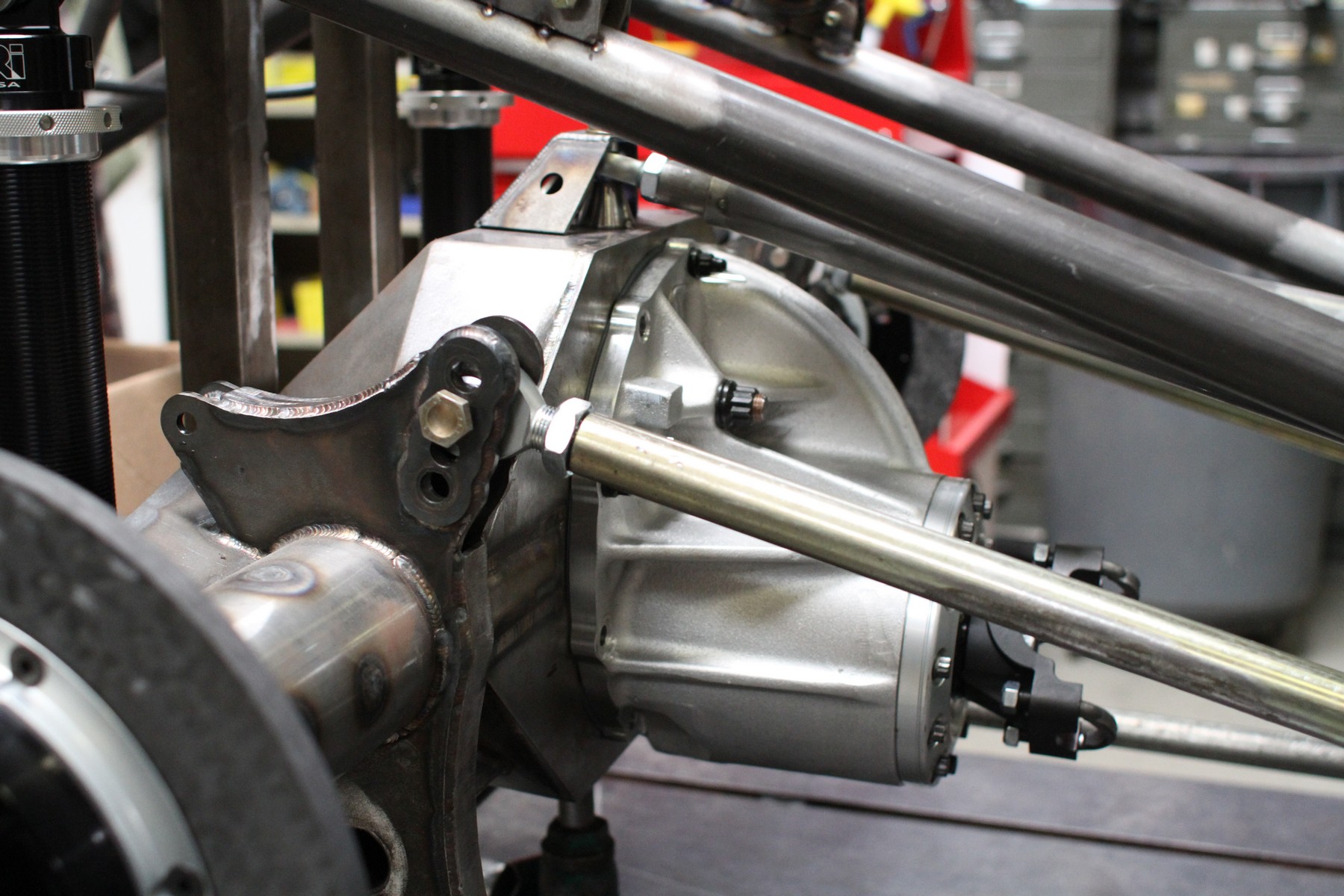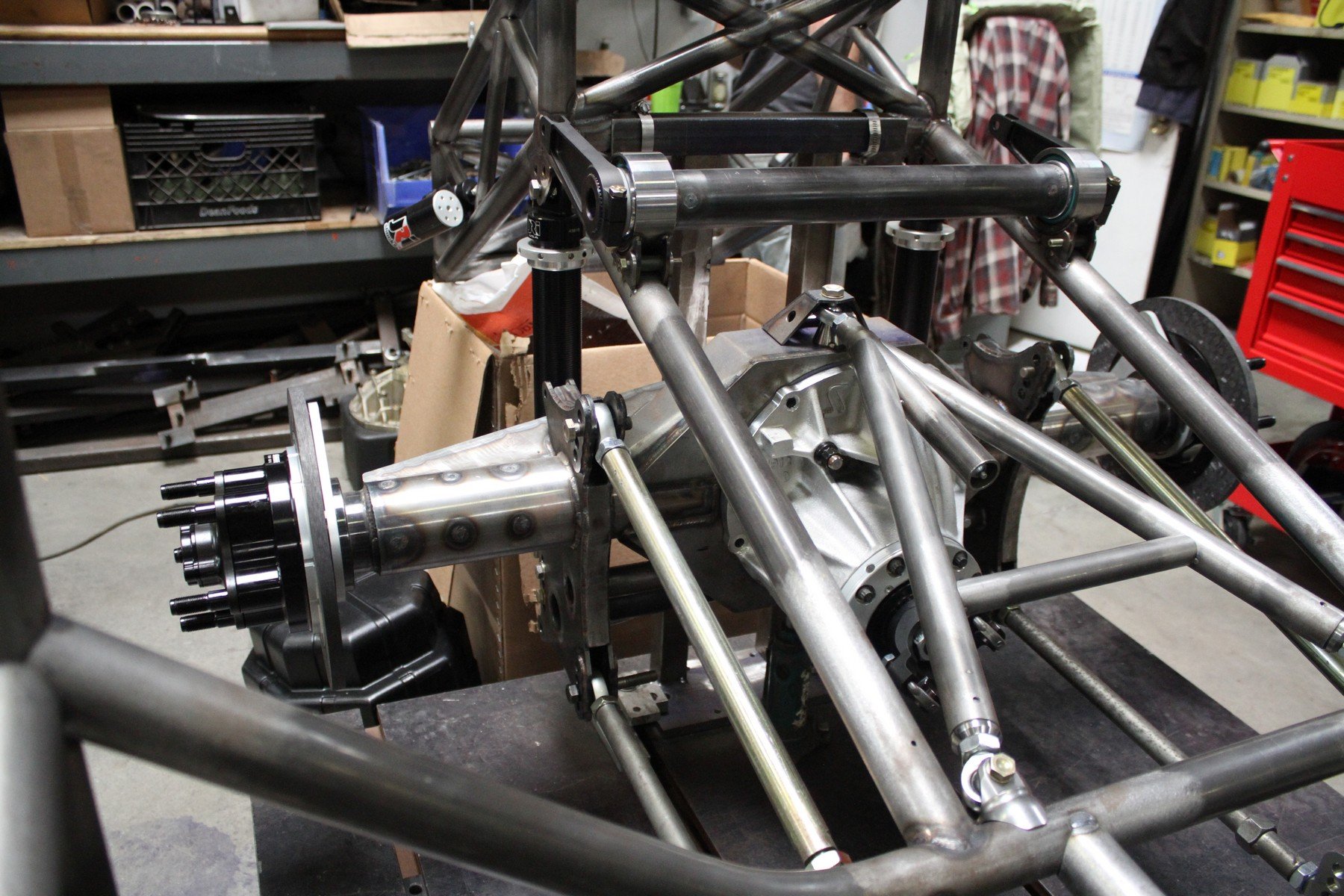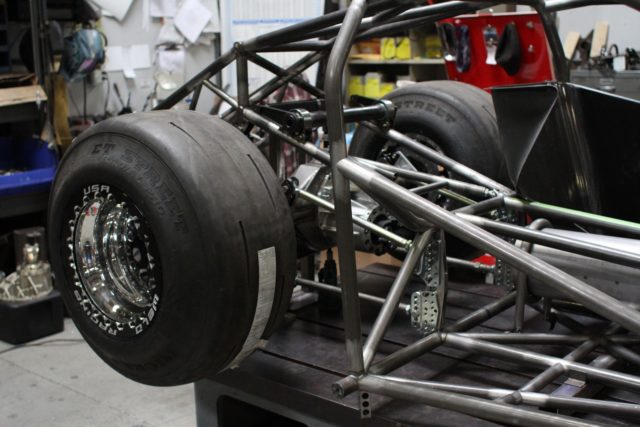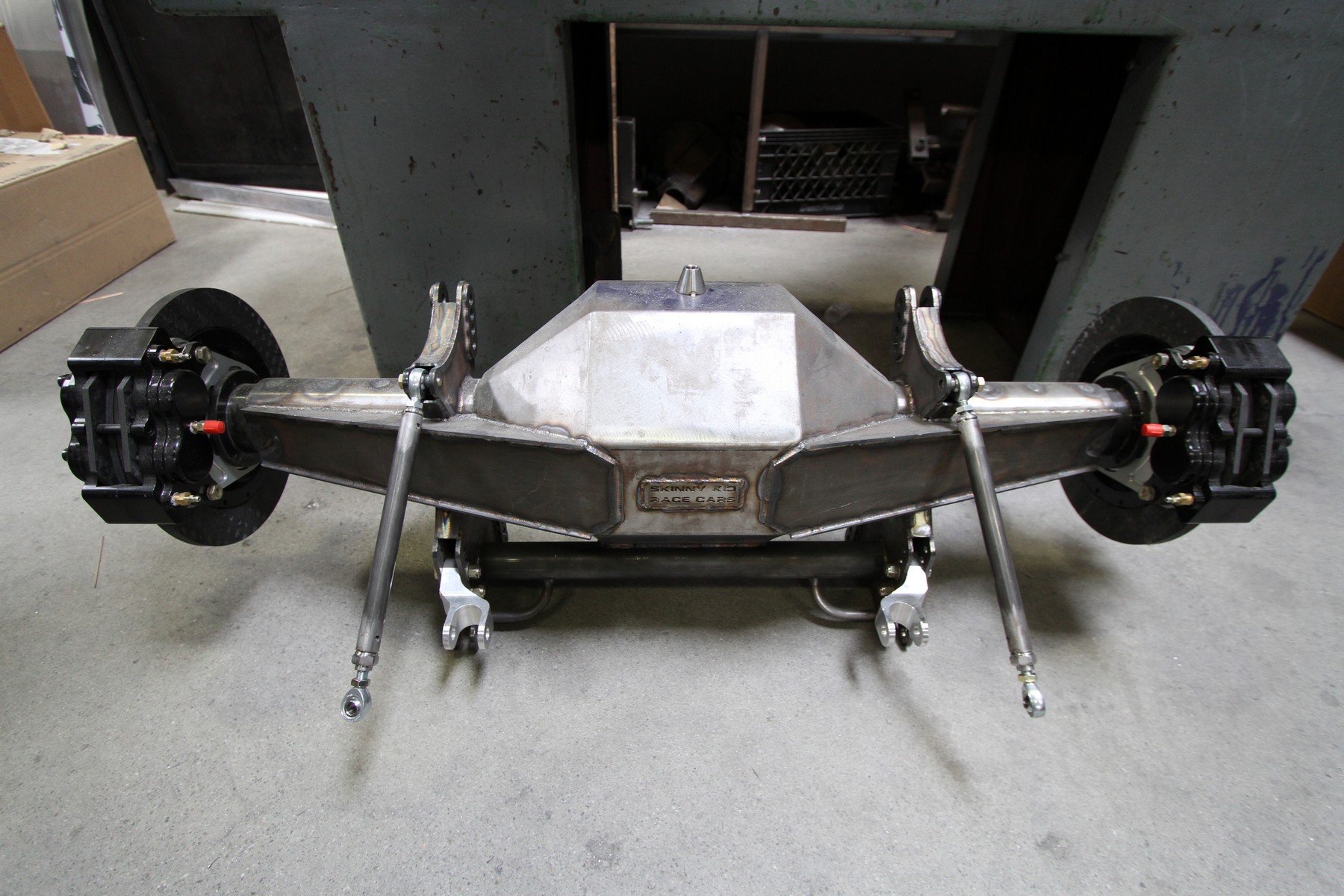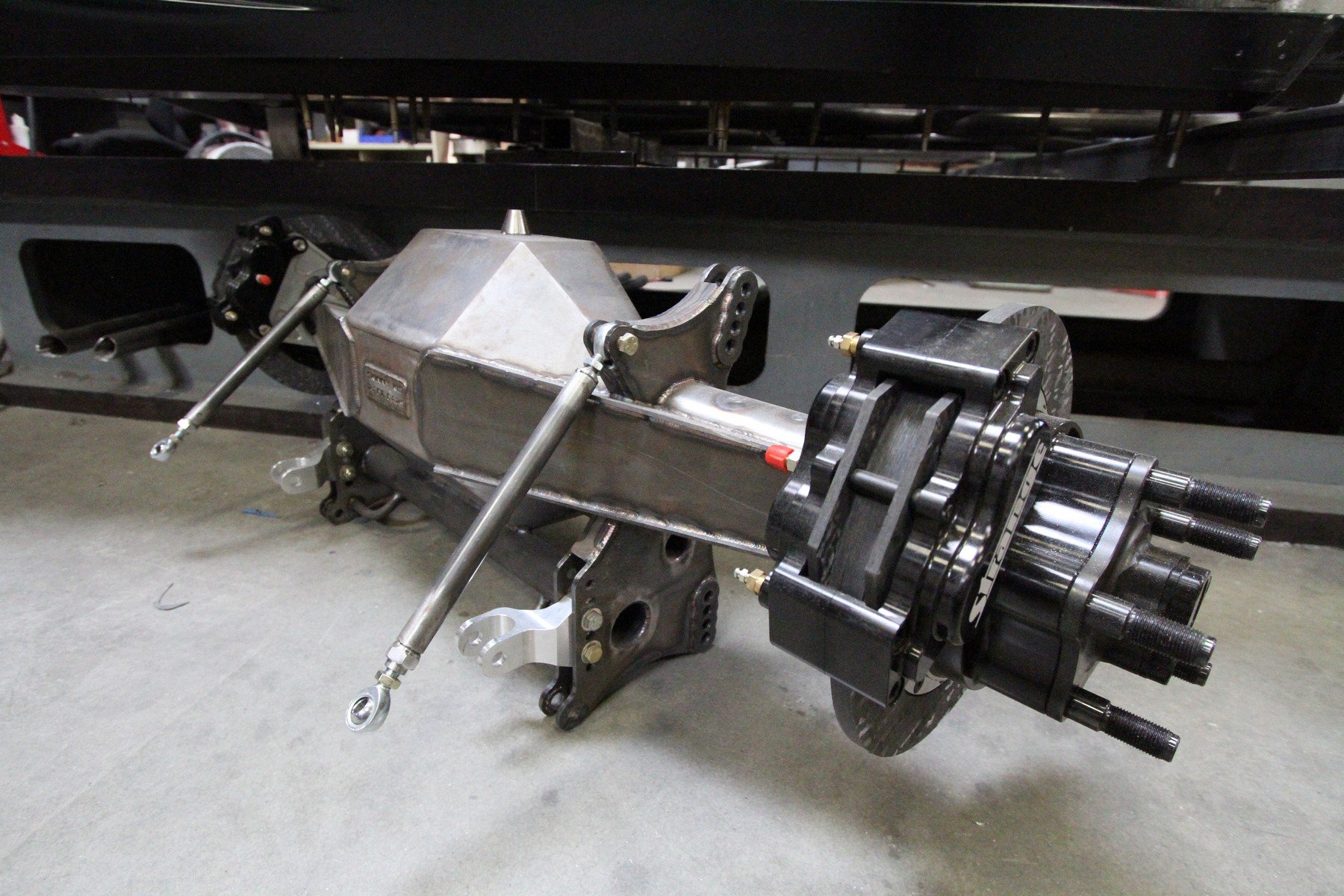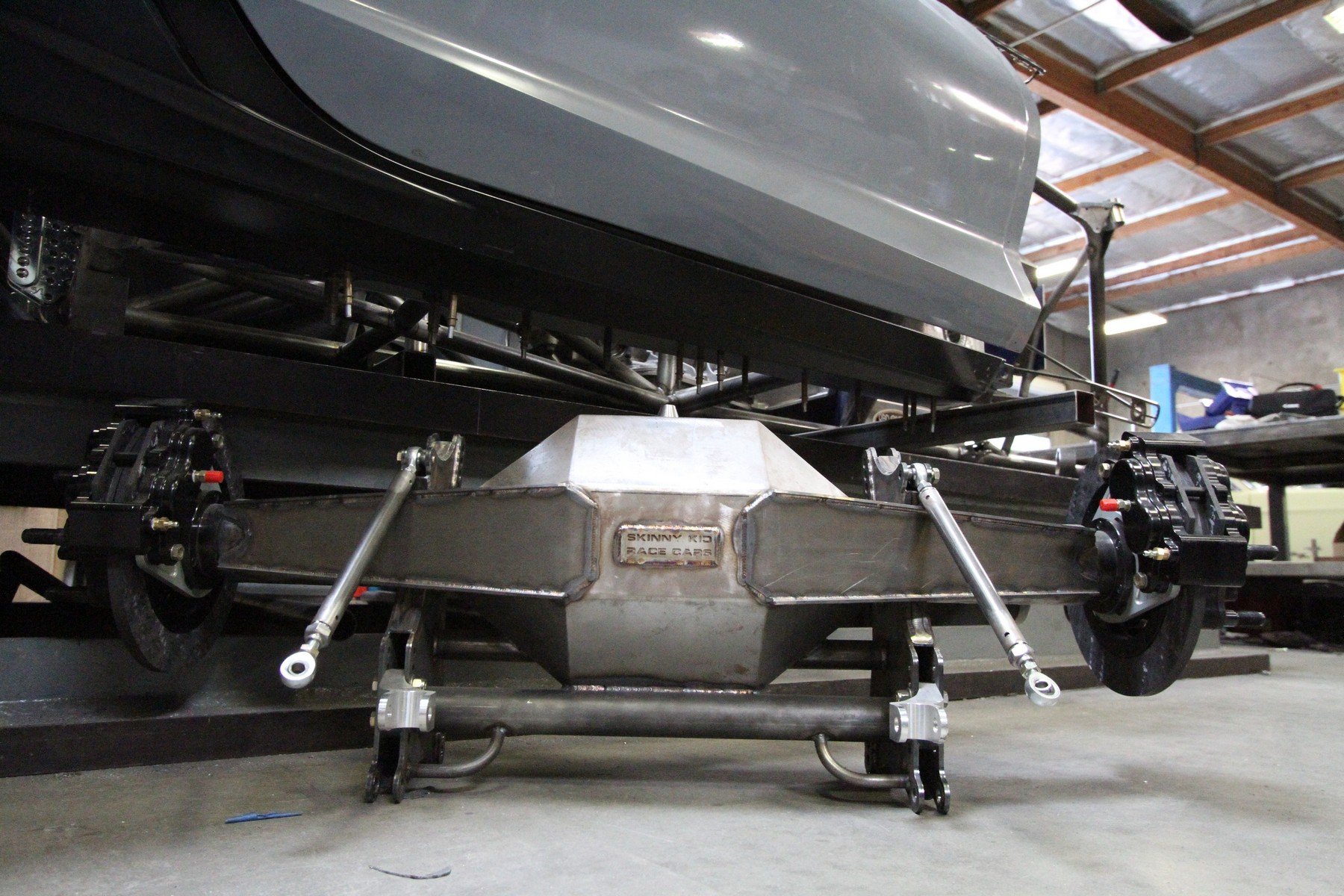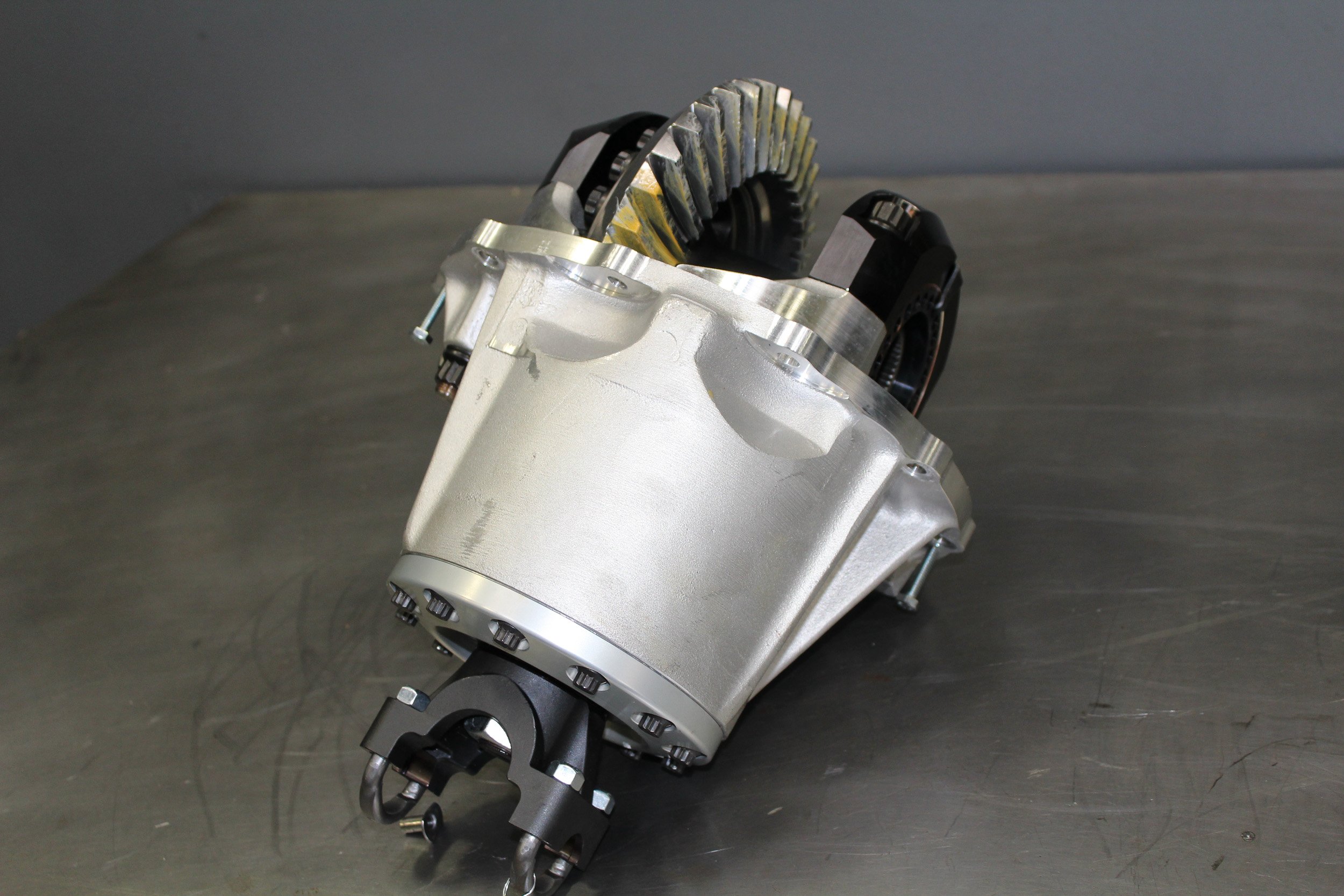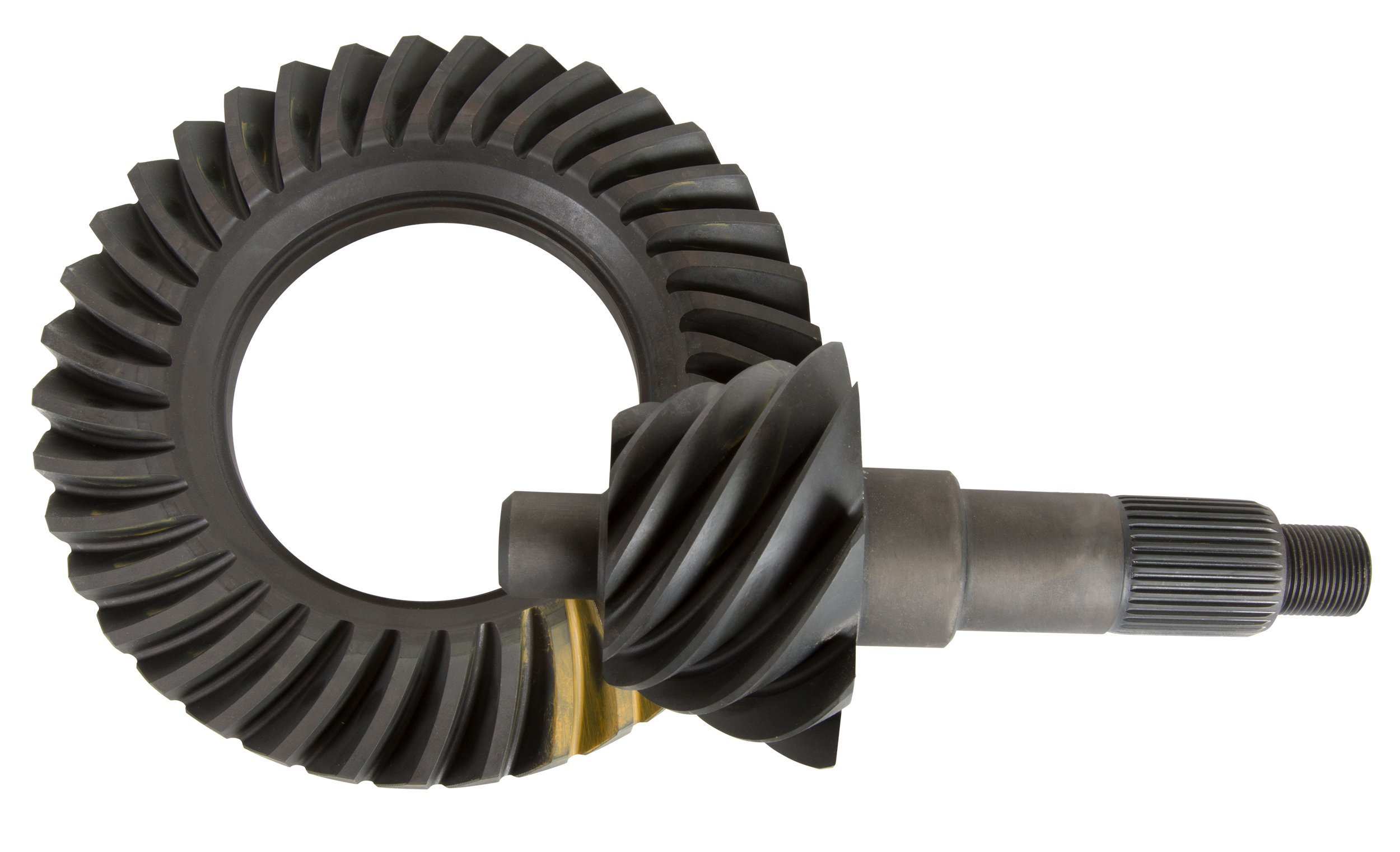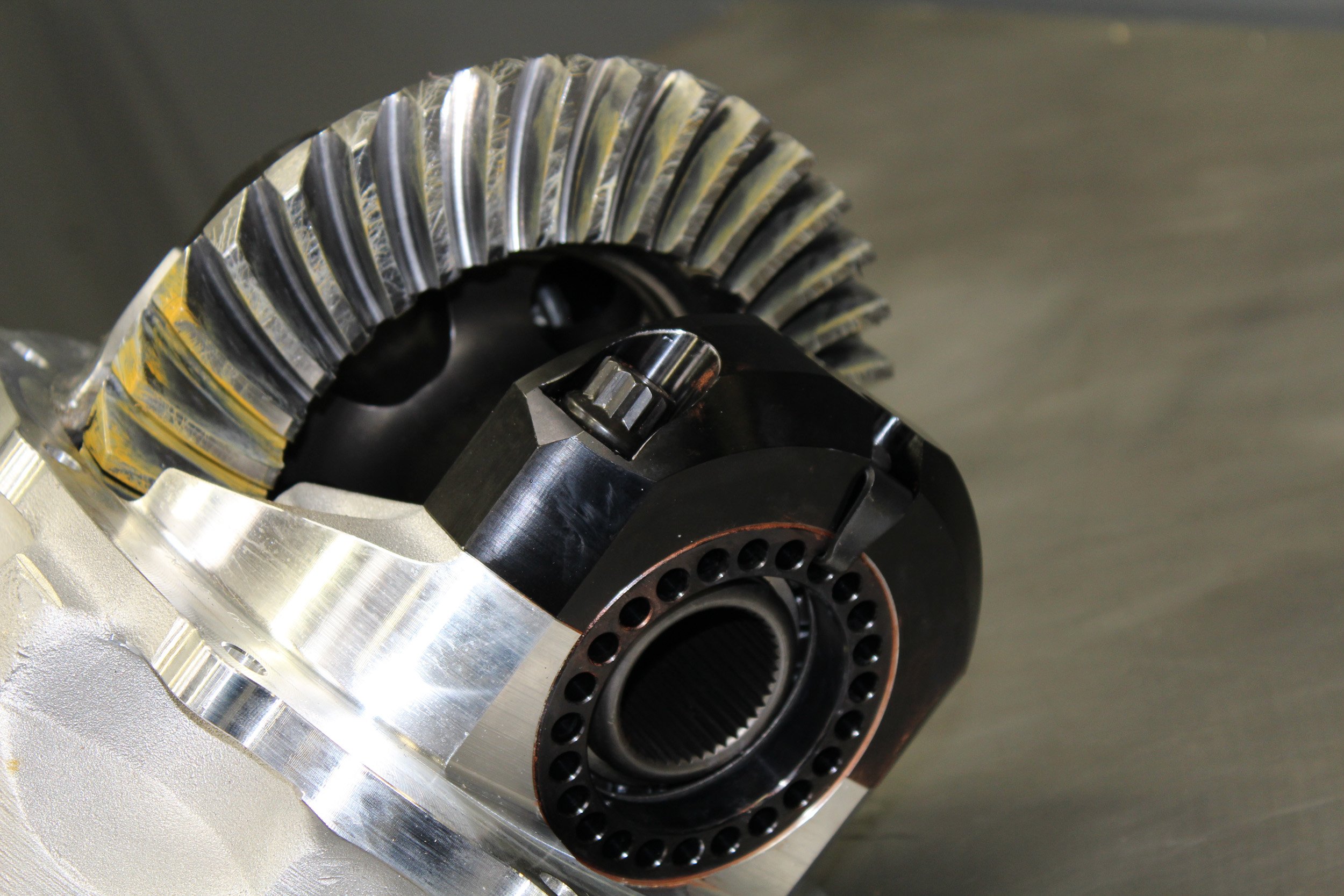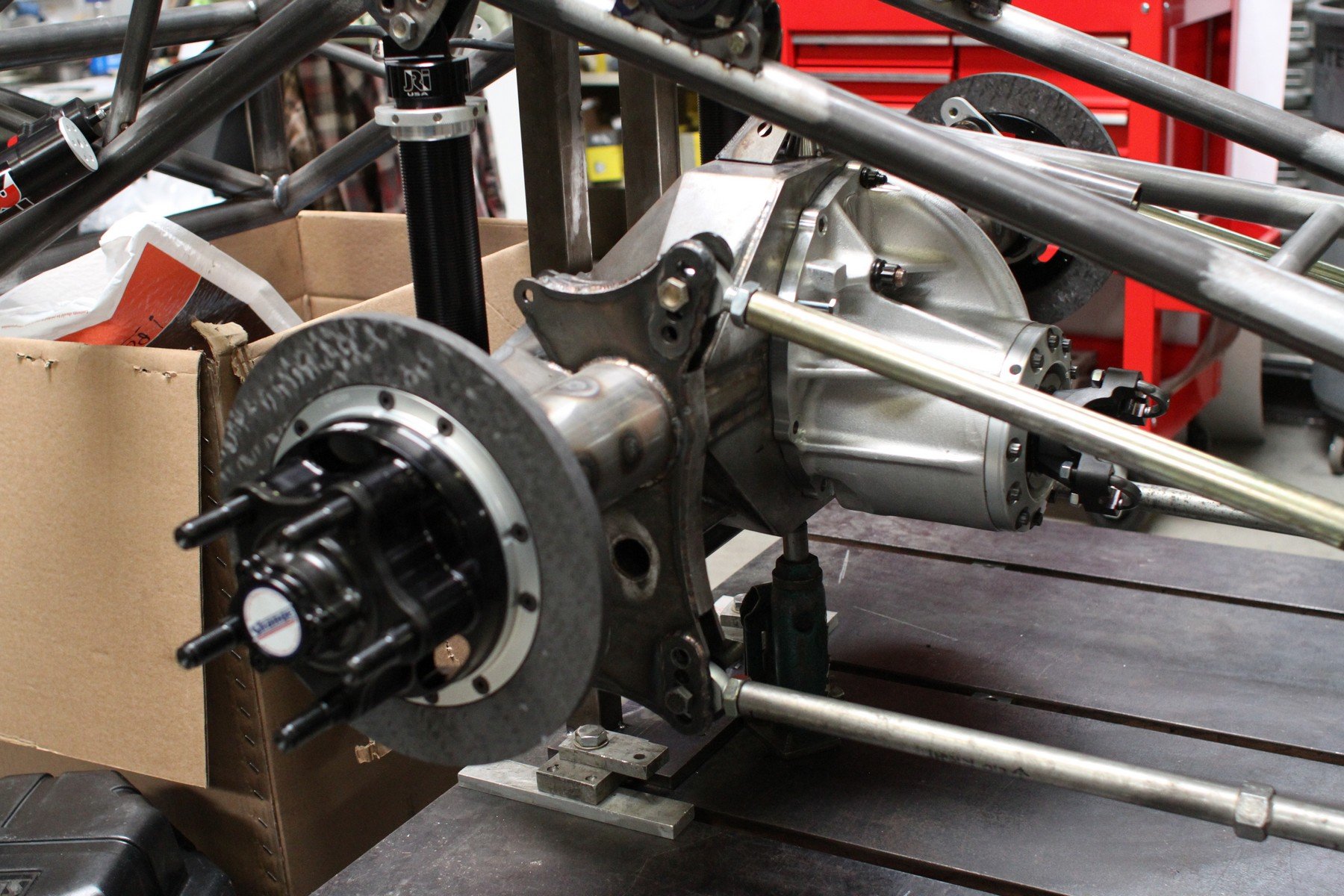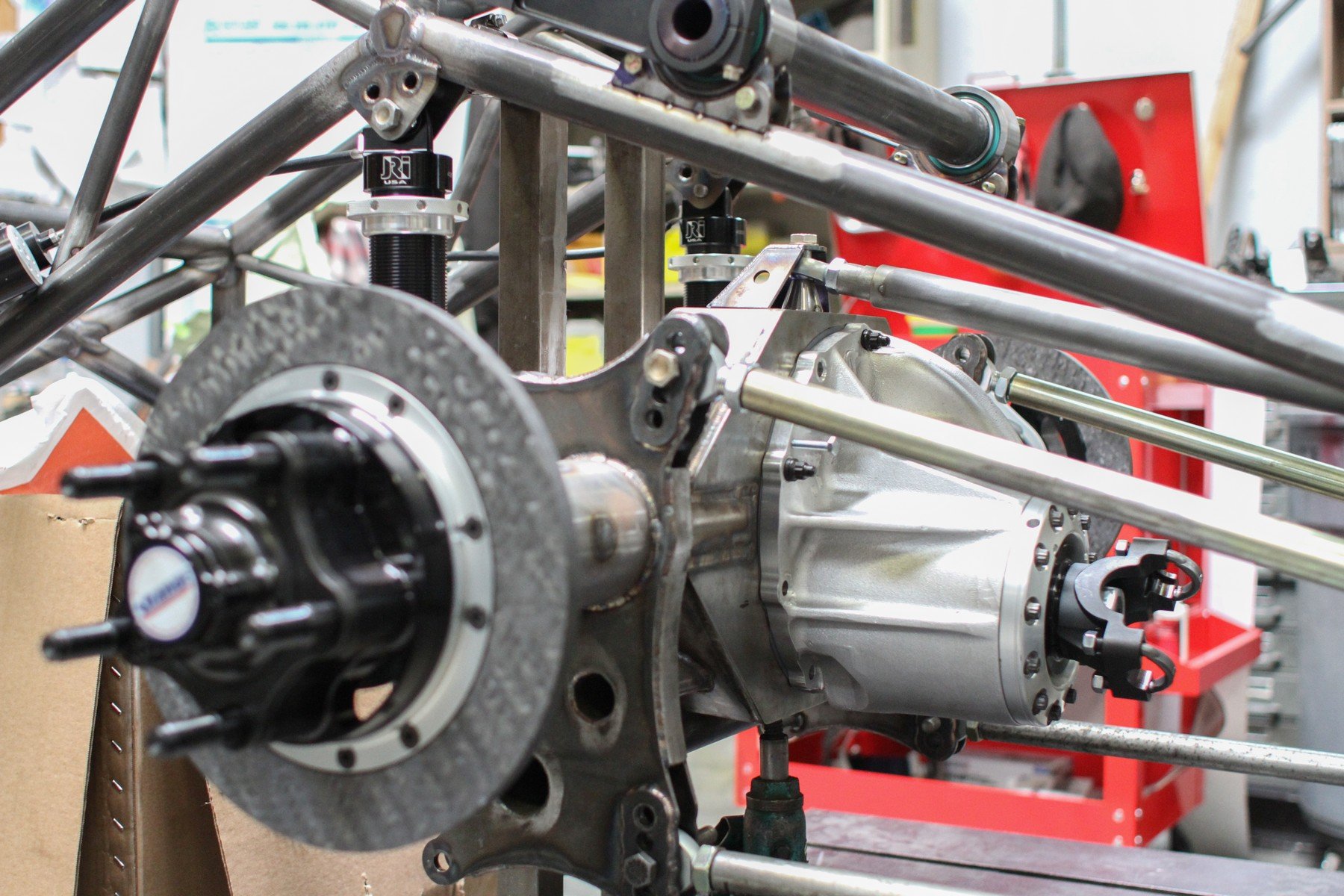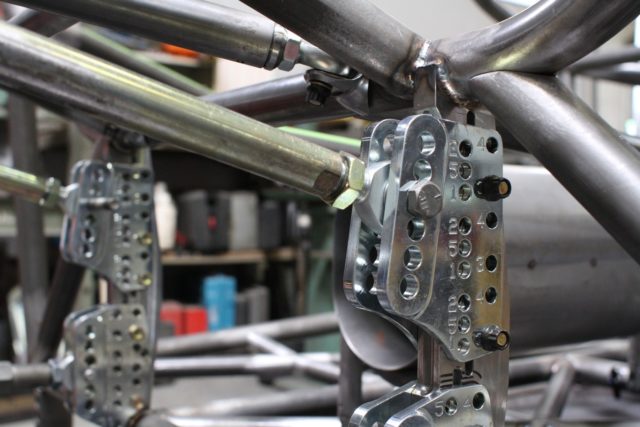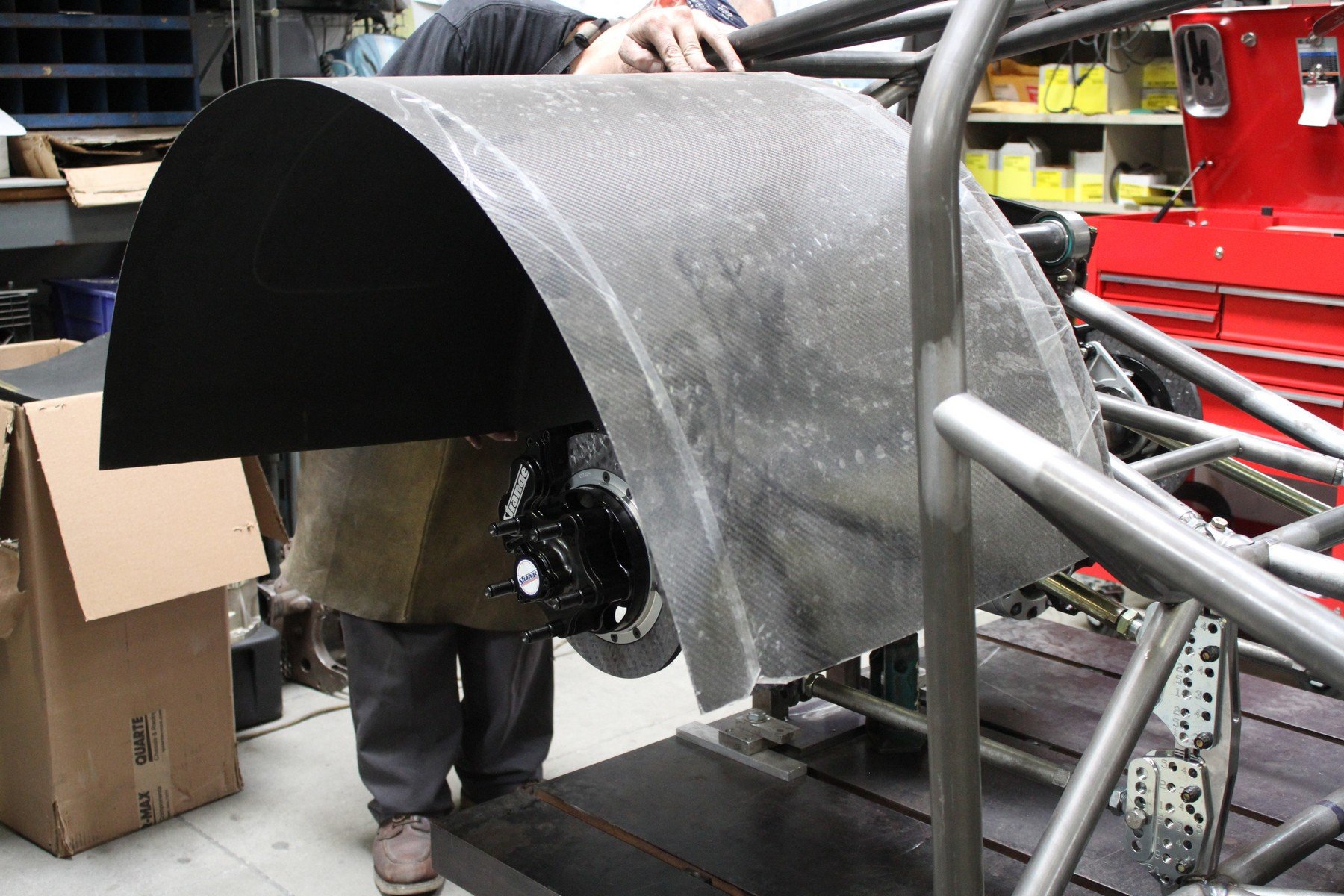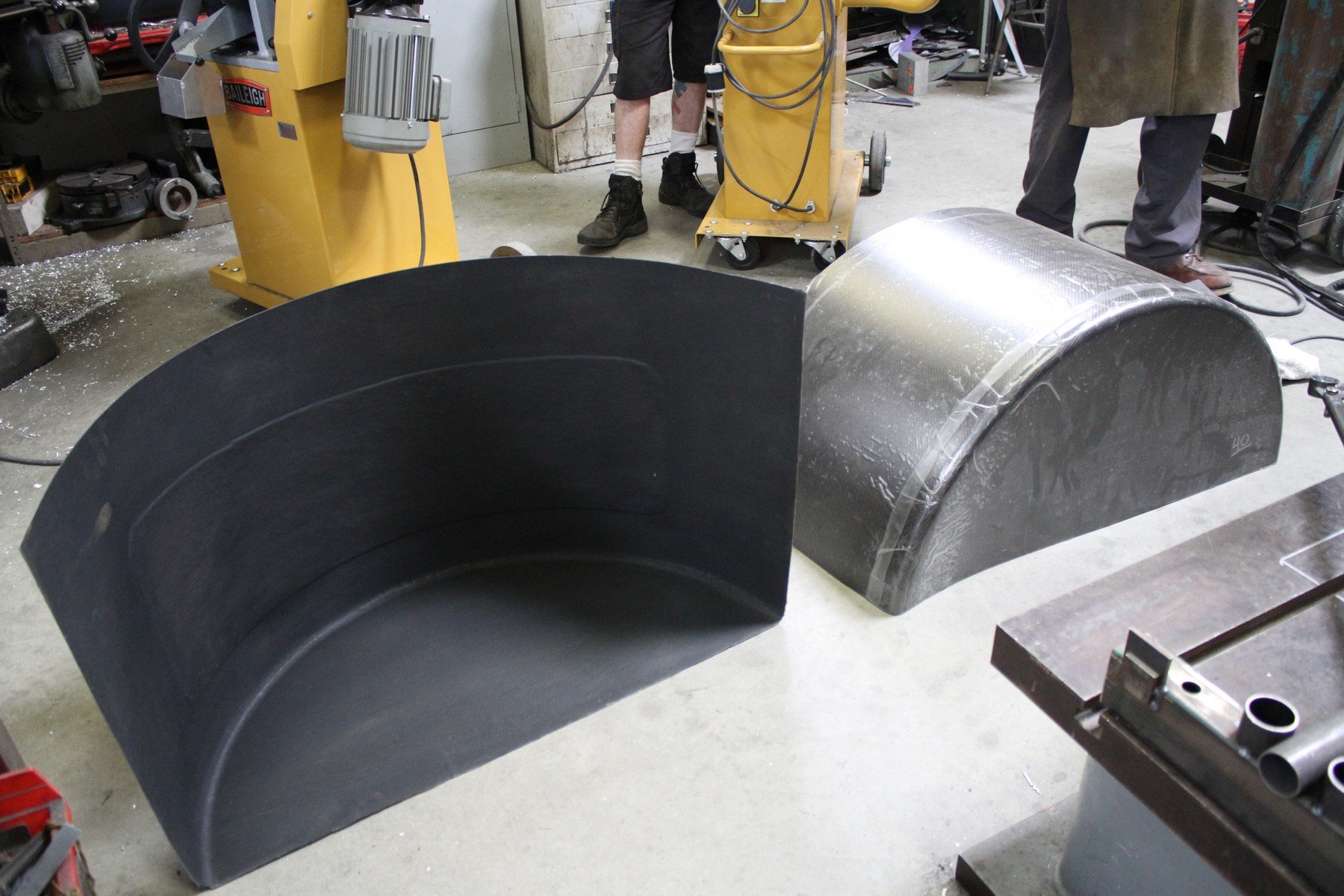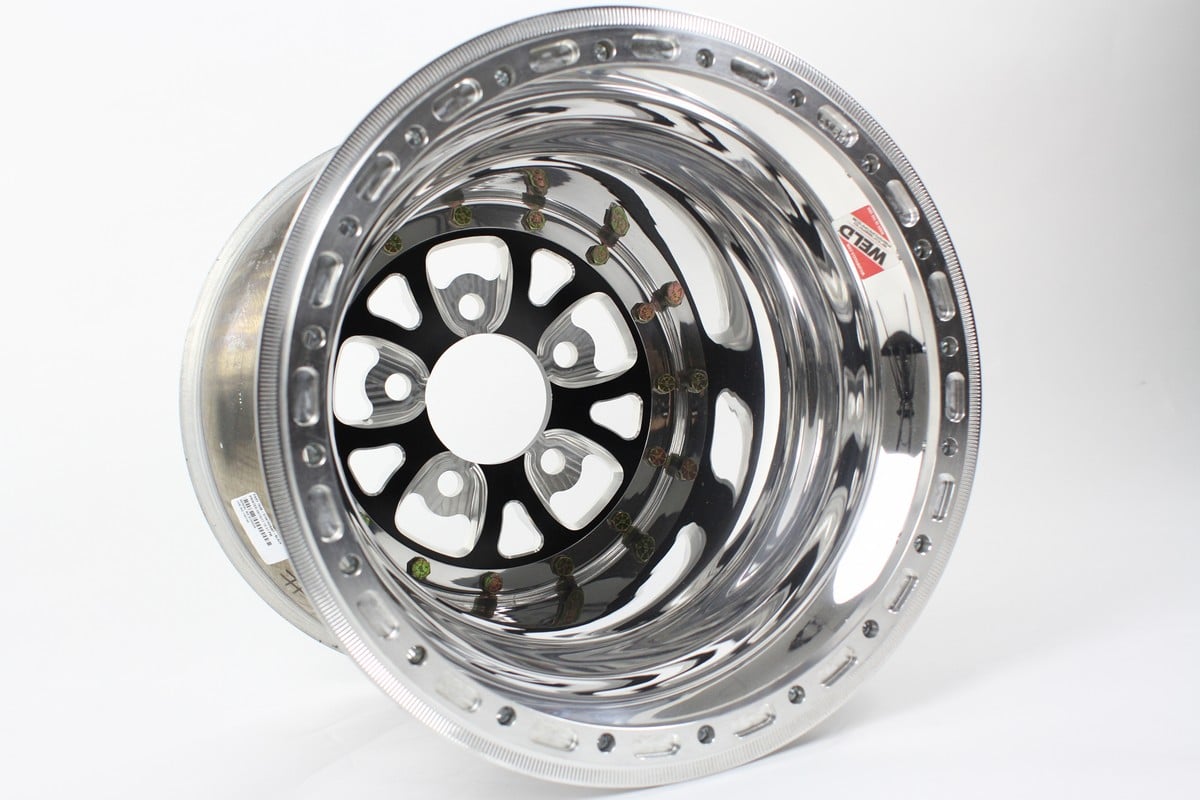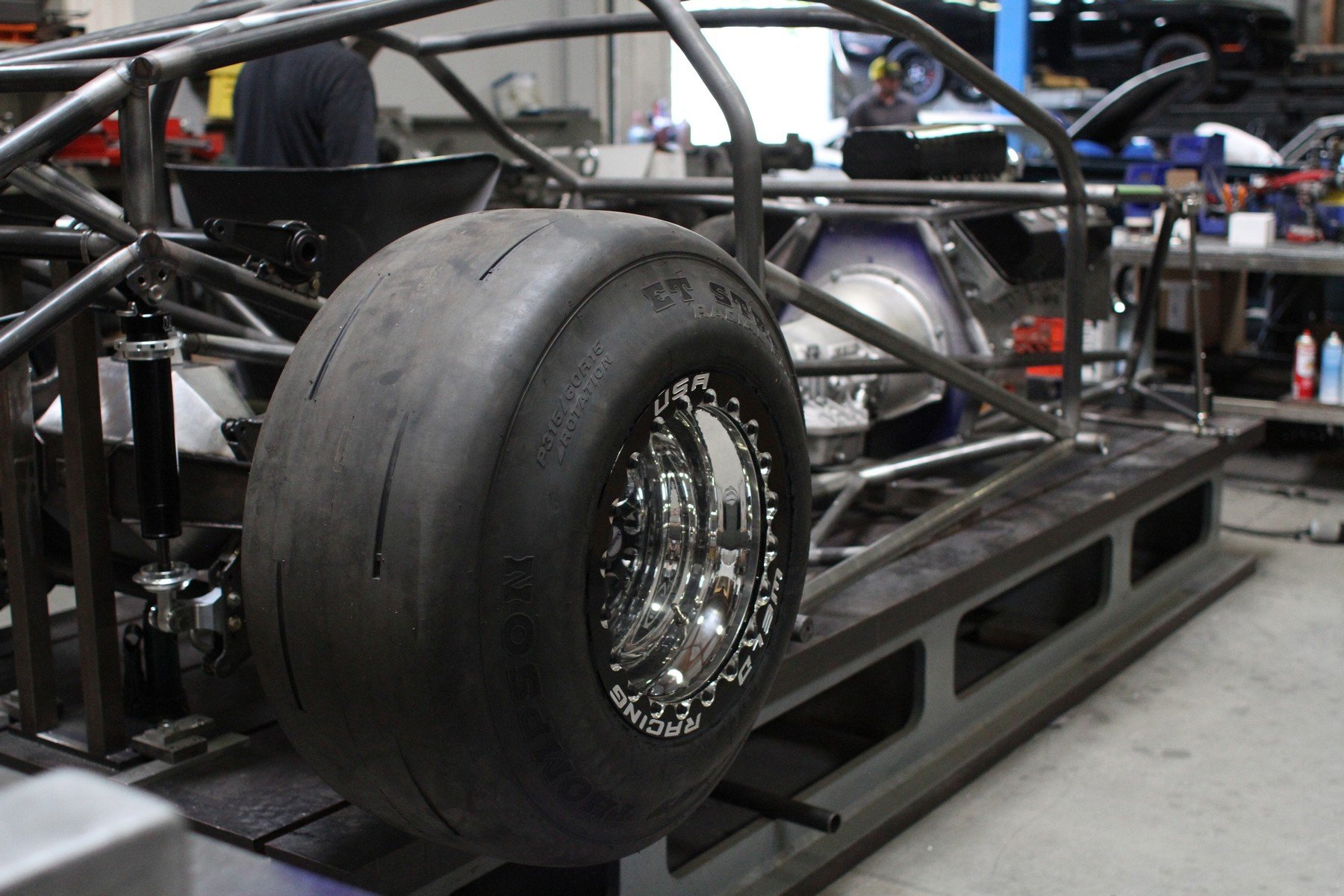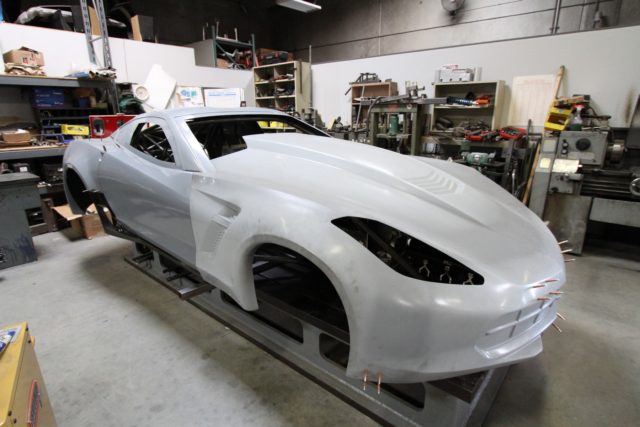Building a cutting-edge chassis for a racecar is more than just throwing some tubes on a jig and welding them together — a plan must be established with defined goals along with a roadmap to get you to the final destination. Our C7 Z06 Corvette Project BlownZ06 is a complex build with grand goals of racing dominance, so a well-thought-out chassis is required to make this happen.
We started by picking a chassis/parts supplier for the build – and that was the team at RJ’s Race Cars/QuarterMax, with most of our dialog with Rickie Jones. RJ’s was to supply the vast majority of all of the chassis components and accessories for the build, including their custom 4-link system, front suspension pieces, and all kinds of parts big and small. PMR Race Cars has been working away on BlownZ06 and in this article, we’ll take a look at what has gone into the rear half of the Corvette to make it its best on race day.
Because BlownZ06 is going to be competing in the fastest radial tire classes, like Outlaw Drag Radial, Pro 275, and Radial versus The World, getting the chassis right is critical to being successful. Tony Mandella and his team at PMR have helped with our previous project cars like BlownZ, so he was our first call when we set sail on this project. He worked hand in hand with RJ’s Race Cars/QuarterMax to develop a complete plan on the car from end to end. This will be our first article in the series on the buildup of BlownZ06 and what goes into building a machine of this caliber.
Building A Drag Radial Machine
The C7 Z06 might be one of the most stylish cars ever built, but making it into a racecar is far from a walk in the park. Building the car to fit into the rules package of small tire racing is a bit of a challenge since the car must retain certain factory body parts and factory wheelbase. The juggling act of staying within the rules gets interesting when you also have to build a car that will function on a radial tire.
The rear suspension travel is one the key factors in making sure this car is going to work since it’s a tube chassis car that will be using a radial. – Tony Mandella
PMR has built a variety of different racecars over the years, but BlownZ06 presented a new challenge for them. The overall design process remained the same, but is much more intense due to how much power this car will be putting down. To make sure the chassis would work with a radial tire, PMR and RJ’s/QuarterMax had to look at the length of the 4-link bars and the overall ride height of the car. Both of these items are important in making sure that the front and rear suspension would work together and function well at the track on the small radial tires.
Making the rearend of the Corvette function as needed required some serious planning from PMR Race Cars.
Getting the rear suspension right on a car of this caliber is what sets the table for consistency and performance at the track. PMR made sure to pay attention to this detail at the very beginning of the chassis building process, according to Mandella.
“The rear suspension travel is one the key factors in making sure this car is going to work since it’s a tube chassis car that will be using a radial. This build is just as exotic, if not more exotic than a Pro Stock car or Pro Mod because it has the same amount of intricate work, and is saddled with additional rules that those cars don’t have to abide by. When we started designing this car we had to look at all the puzzle pieces individually and see how they would play into the rest of the car, as well. You try to plan everything out good enough that you don’t put yourself in a corner later in the build that requires a compromise or redo on work,” he says.
The RJ Race Cars 4-Link system is the key to getting the power down to the track on the radial tire for BlownZ06.
Before a single tube was welded on the jig, PMR examined where they would be putting the RJ’s 4-link in relation to how the car would sit. This includes working to figure out how high they wanted to put the brackets in the car to set the ride height correctly, and more.
You have to look at the front suspension and framerails when placing them to make sure everything is tied together, otherwise the car will never function correctly and transfer weight. -Tony Mandella
Going with a 4-link setup on BlownZ06 was the most logical choice due to the amount of adjustability the suspension offers. The RJ Race Cars Extreme 4-link got the call to be used because it acts like a slider system and provides five times more adjustment. We cover the RJ Extreme 4-link more in this article here, but Mandella does a great job breaking down the RJ unit versus your standard 4-link. “Your traditional 4-link would just have a series of holes on the chassis and on the rearend where you could move the bar only so much. With this RJ Extreme 4-link, it’s almost infinitely adjustable down to the 1/8-inch to help fine-tune everything.”
In addition to the RJ’s 4-link, we also checked a huge array of parts from the RJ’s catalog including the RJ Extreme Pro Mod anti-roll bar, RJ’s 4-link rod end kit, RJ’s shock mounts, and the 40-inch QuarterMax carbon fiber wheel tubs.
The Rear Suspension Parts
BlownZ06 is going to be motivated by a potent 548 cubic-inch Pro Line Racing Hemi and ProCharger combination. With that much power on tap, getting it to the ground is going to require some heavy-duty components, like a fabricated 9-inch rearend housing. To get the job done an all chrome-moly unit from Skinny Kid Race Cars was selected to help rotate the drag radials on BlownZ06.
Skinny Kid Race Cars built a bomb-proof Fab-9 rearend packed with ultra-strong parts from Strange Engineering.
“Skinny Kid has a lot of experience with building these cars and knows what’s required when fabricating a heavy-duty rear-end that can take this level of abuse. The fabricated 9-inch is made of chrome-moly plates and has extra bracing along with larger axle tubes making it ideal for applications like this. Where the 4-link attaches and the parts used to attach it to the rear-end are also a lot stronger, as well, that just makes picking one of these the right choice,” Mandella explains.
The Skinny Kid Race Cars rear-end needed some jewelry to hang from it and good parts to fill it, so Strange Engineering parts were ordered to get the job done. BlownZ06 will use carbon fiber brakes, Strange 40-spline axles that have been gun drilled, Strange “HD” 40-spline lightweight spool, and a beefy Strange 3.812 Ultra Case center section to hold the US Gear 9.5-inch 3.70 Pro Gear in place. Strange’s center section will support upwards of 3,000 HP.
The Strange Ultra Case makes the perfect home for the Pro Set gears from US Gear.
We worked with the team at US Gear to supply the ring and pinion. This setup is a Pro Gear style, 9.5-inch diameter, 3.70 ratio. Made of 9310 Steel, US Gear says is a “Top Fuel” spec material of considerable strength and durability. The Strange center section is capable of supporting up to a 10-inch gear, but a 10-inch gear is only available in 3.89 and up ratios. However, US Gear confirms that a 3.70 gear in 9.5-inch will have a considerable lifespan.
Going fast is fun, but being able to stop at the end of a pass is pretty important. To bring the Corvette to a stop, Strange’s Pro Carbon Brake Kit for 40-spline floater axles was added to the rearend. These brakes are nearly 10 pounds lighter than a steel brake setup, so when you’re counting the pounds like we are with BlownZ06, that level of weight savings is huge.
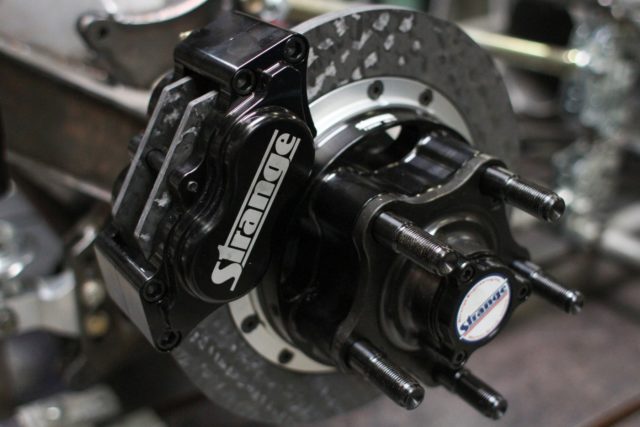
Carbon brakes from Strange were a must on BZ06 to make sure the Corvette can stop on a dime at the end of each pass.
According to JC Cascio from Strange Engineering, these brakes are what’s needed when trying to stop a heavy car like BlownZ06. “The stopping power of the carbon brakes is what makes them such a great fit for high horsepower cars like this. They actually work better the hotter they get, so if you have to use them in an emergency due to a chute failure they won’t fade. Also, because these are made of carbon they won’t have the same type of brake fade you have with steel rotors.”
Because the rearend of BlownZ06 is a floater-style, a specific and strong type of rear axle is needed. The 40-spline gun drilled axles that are made from Strange’s Hy-Tuf material were the best choice for the task. The Hy-Tuf material is a steel that uses a low amount of carbon and a high amount of nickel, manganese and molybdenum to make it extremely strong.
Inside the Skinny Kid rearend is a set of floater axles from Strange that are built specifically for this type of heavy-duty application.
A floater rearend and axles are a must at the 3,000 horsepower level that BlownZ06 will be operating in to provide the strength necessary.
“These axle tubes are much stronger than the flanged-style, so with a floater rearend like this, it adds an extra layer of safety. Also, these axles have much less deflection at the power levels they will see in this car. With less deflection they will be less likely to fail, and will allow the power to be put down better,” Cascio says.
The crown jewel of the rearend parts from Strange for BlownZ06 is their Aluminum Ultra Case assembly. This unit is made from 206-T4 heat treated aluminum and features billet aluminum main caps and solid steel adjuster nuts. This center section is all about strength and making sure the gears maintain the mesh they need to at all times.
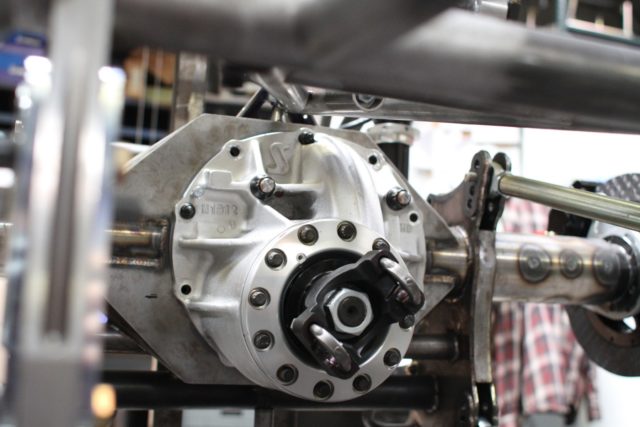
The Strange Ultra Case is what keeps the rear tires turning reliably on each boosted pass BlownZ06 will make.
“This case is also designed to take the abuse this power level will cause and be able to deal with a heavy car trying to put that power down. That extra strength also helps to make sure the gears last longer when they’re put under so much stress. At this power level, keeping the integrity of the case intact helps to keep the gears from not meshing correctly and breaking teeth or failing. Since this center section has so much more bracing, the deflection inside the case is reduced, so the gears don’t bind and are able to move more freely,” Cascio says.
The rear shocks that are providing the dampening support for the rearend of BlownZ06 are a set of drag radial specific shocks from JRi. These shocks are 21.5 inches in length and that helps to provide the critical chassis separation a radial tire car needs to work on the sticky track surface.
The JRi rear shocks are specifically designed to provide the travel needed on a radial tire car.
We go into more detail about these shocks right here if you want to see just how much adjustment they have and how they function.
Tubs, Tires, Wheels, And Body Panels
Since the Corvette needed a bit more space for the 315 Mickey Thompson radial we are putting under it, a set of carbon wheel tubs from RJ Race Cars had to be added in by PMR.
“We went with these RJ’s tubs for weight purposes; there’s practically no weight to them when you compare them to others. The RJ units already come with a great finished look and that is really nice. As you’re installing them it’s all about using good templates to make sure you get the fit right the first time and avoid any issues. The template we made out of cardboard allowed us to make sure we cut the carbon tub right the first time and made for a better fit,” Mandella explains.
The tire of choice for the rear of BlownZ06 will be a set of Mickey Thompson 315 ET Street Radial Pros. This tire, with its outstanding technological advances, is one of the biggest reasons that radial tire cars have been able to dip into the 3.70 range in the eighth-mile. The 315 uses Mickey Thompson’s special R2 rubber compound and uses the same proven tread pattern its cousin, the 275 Pro, has.
The Mickey Thompson tires will find a home under the rear of BlownZ06 on a set of Weld Racing V-Series wheels. Since the Corvette is going to be channeling a lot of power to the tires these beadlock-style wheels are a must to keep the tires from spinning on the wheel.
These wheels carry a SFI 15.1 rating and are made of 6061-T6 forged aluminum. You can learn more about these killer wheels in this article that goes into more detail about their construction.
The Weld Racing wheels and Mickey Thompson tires are the perfect match on the rear of BlownZ06!
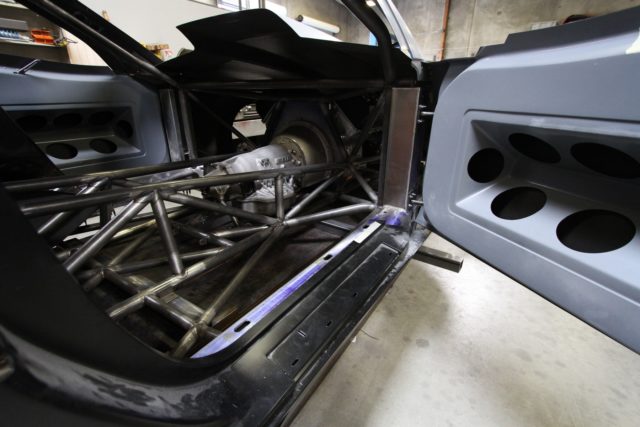
Getting the OEM and aftermarket body panels to fit together was an interesting challenge for PMR on the BlownZ06 build.
One of the unique parts of the BlownZ06 build is the difficulty of incorporating the required stock components like the factory frame-rails and certain body parts into the build. PMR stepped up to the challenge of integrating the stock parts with the aftermarket parts to create a car that is going to look almost entirely factory.
Body Talk
So how exactly does the body get attached to the BlownZ06 chassis? PMR will overlap the body panels and use high strength rivets to bond them together. Everything will be connected to the round tube chassis via surface plates that come off the tubing and meet the carbon fiber. Smash rivets will be used to hold those together so the body stays in place during 200 mph laps at the track.
“We have the OEM door sills, OEM surrounds along the rocker area; in this car we also incorporated the OEM rocker which is also the factory frame of these Corvettes. Some rules doesn’t require factory frame rails, but in some classes – per the rules – we had to have factory frame rails, door jambs, and rear quarter panels, in the car. We started with those surrounds and then went to tying them into the back end of the car — the quarter panels, deck lid portion, and the roof,” Mandella says.
Some might be wondering why a donor car wasn’t used for the build, and the answer is that it was actually cheaper and easier to use aftermarket parts.
“We used the Chevrolet OEM corvette frame rails, OEM door sills, OEM inner door panels, and patched in the Chevy Z06 rear quarter panels,” Mandella explained. “It was a pain when are you are working with an all-fiberglass car from the factory, but that’s what we needed. The biggest thing was making sure we added in the factory frame-rails since that is a big portion of the rules in some sanctions.”
As you can see a lot of thought and work has gone into the chassis and rear-end design for BlownZ06. PMR has paid close attention to all of details to make sure the Corvette is going to use every ounce of power the Pro Line Racing Engine can produce with the big ProCharger spinning on the front of the car. In our next article we will cover the front portion of the car, including the suspension and what went into its design and fabrication. Stay tuned right here to Dragzine for the details!

